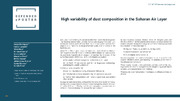Por favor, use este identificador para citar o enlazar este ítem:
http://hdl.handle.net/20.500.11765/14004
High variability of dust composition in the Saharan Air Layer
Registro completo de metadatos
| Campo DC | Valor | Lengua/Idioma |
|---|---|---|
| dc.contributor.author | Rodríguez González, Sergio | es_ES |
| dc.contributor.author | Lucarelli, Franco | es_ES |
| dc.contributor.author | Nava, Silvia | es_ES |
| dc.contributor.author | García Álvarez, María Isabel | es_ES |
| dc.contributor.author | Calzolai, Giulia | es_ES |
| dc.contributor.author | Chiari, Massimo | es_ES |
| dc.contributor.author | Cuevas Agulló, Emilio | es_ES |
| dc.contributor.author | López Solano, Javier | es_ES |
| dc.contributor.author | Marrero, Carlos | es_ES |
| dc.contributor.author | Prats Porta, Natalia | es_ES |
| dc.date.accessioned | 2022-10-19T13:43:51Z | - |
| dc.date.available | 2022-10-19T13:43:51Z | - |
| dc.date.issued | 2019 | - |
| dc.identifier.citation | EcoDesert International Symposium (2019) | es_ES |
| dc.identifier.uri | http://hdl.handle.net/20.500.11765/14004 | - |
| dc.description | Poster presentado en: EcoDesert International Symposium, celebrado en Almería (España) del 20 al 22 de febrero de 2019. | es_ES |
| dc.description.abstract | Every year, 1500-2000 Tg of dust are emitted from soil to the atmosphere. The resulting aerosol dust particles have a size ranging from sub-1 μm to tens of microns, and a lifetime from hours to two weeks. Aerosol dust impacts on climate and on biogeochemical cycles, and is involved in the Earth System. About 50 to 70% of global dust emissions occur in North Africa. Most of dust exports to the Atlantic occur in the so-called Saharan Air Layer, a warm, dry and dusty high-altitude air stream that reaches the Americas. At the Izaña Observatory, 2400 m.a.s.l. in Tenerife (Spain), we studied (i) the variability of dust composition in the Saharan Air Layer, (ii) the North African sources and (iii) the large-scale meteorology prompting the variability observed. For this purpose, we performed (i) one-hour resolution sampling of aerosols, followed by (ii) PIXE (Particle bombing Induced X Ray Emission) analysis, and (iii) further data interpretation with meteorological tools and satellite observations. During one-week dust events, we found that the ratios of some elements (e.g. Ca, Mg or K, among others) to Al (soil tracer) changed by a factor of about 2 in a few (5-7) hours. This high variability in dust points to a concatenation of the sources contributing to dust over the North Atlantic. By back-trajectory analysis, Median Ratios At Receptor plots and MODIS and MSG – SEVIRI satellite observations, we observed that the sources activated during the study period were located in topographical lows located in three main regions: NE Algeria – Tunisia (dust rich in Ca, Sr, Mg and K), W Algeria-E Morocco (Na and Cl) and N Mali-S Algeria (rich in Si and Fe). In a six-day period, there were seven concatenated impacts from the sources identified, which were traced by the variability in the ratios of the different elements to Al. These results provide a new and more complex view of the dust exported to the Atlantic, compared to the simplistic approach based on bulk-dust measurements and modelling. These results have implications of the impact and influence of dust on climate. | es_ES |
| dc.language.iso | eng | es_ES |
| dc.subject | Aerosol dust particles | es_ES |
| dc.subject | Dust emissions | es_ES |
| dc.subject | Satellite observations | es_ES |
| dc.title | High variability of dust composition in the Saharan Air Layer | es_ES |
| dc.type | info:eu-repo/semantics/conferenceObject | es_ES |
| dc.rights.accessRights | info:eu-repo/semantics/openAccess | es_ES |
| Colecciones: | Otros póster | |
Ficheros en este ítem:
| Fichero | Descripción | Tamaño | Formato | ||
|---|---|---|---|---|---|
| Rodriguez_ECODESERT_2... | 420,27 kB | Adobe PDF |  Visualizar/Abrir |
Los ítems de Arcimis están protegidos por una Licencia Creative Commons, salvo que se indique lo contrario.





